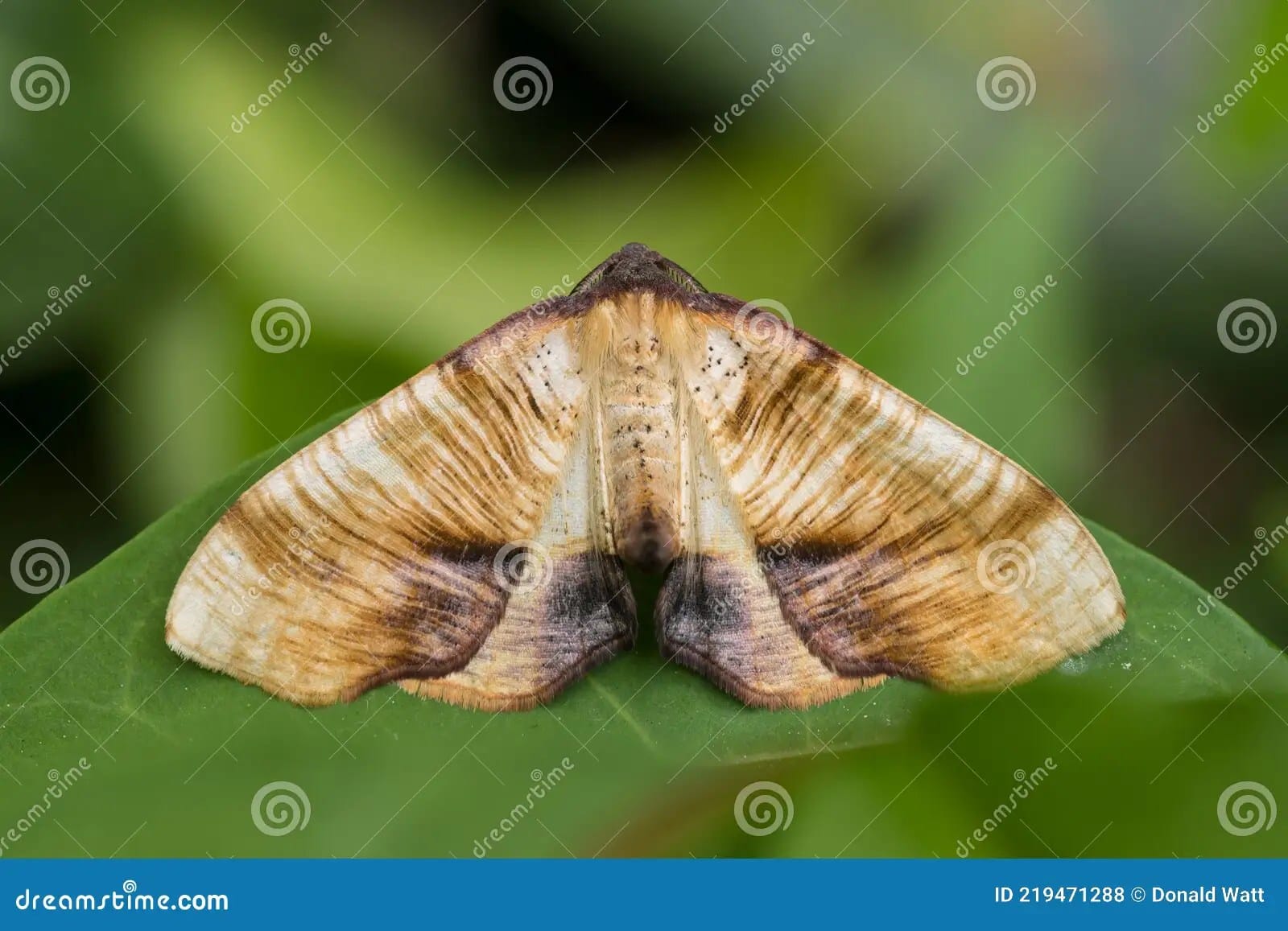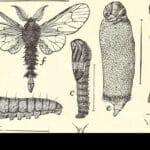Dressed for Deception: The Art of Blending In
Imagine strolling through a European woodland, sunlight dappling the forest floor. A gentle breeze rustles the leaves, and for a moment, you think you spot a piece of charred paper clinging to a branch. But look closer – it’s moving! This, my friend, is the magic of the scorched wing moth caterpillar, a master of disguise that uses camouflage to blend seamlessly into its surroundings.
Don’t let its drab attire fool you; this caterpillar, growing up to an inch and a half long, is a fascinating creature. Its muted palette of grayish-brown, speckled with darker markings, makes it practically invisible against the bark of trees. This camouflage is crucial for survival. By mimicking its surroundings, the caterpillar drastically reduces its chances of becoming a tasty snack for birds and bats.
But its camouflage isn’t its only trick. The “scorched wing” part of its name comes into play during its adult stage. After spending its youth munching on leaves from trees like oak, birch, and beech, the caterpillar undergoes a remarkable transformation. It burrows underground, patiently waiting to emerge as a moth with a wingspan of just over an inch. Its wings? They’re something special. Adorned with dark, irregular patterns, they resemble, you guessed it, scorched or burnt paper.
This clever disguise likely helps the moth avoid becoming a feathered snack. After all, what bird would want to waste time chasing after something that looks like it just escaped a bonfire? This remarkable adaptation highlights the incredible ways nature equips its inhabitants to thrive.
While the scorched wing moth caterpillar isn’t considered endangered, its future, like many insects, is deeply connected to the health of our environment. Habitat loss and climate change pose potential threats, making it more important than ever to understand and appreciate these creatures.
The next time you find yourself wandering through a woodland, take a moment to appreciate the subtle wonders around you. You might just be lucky enough to spot a scorched wing moth caterpillar, a testament to the power of adaptation and the artistry of nature’s camouflage.
Cracking the Code: How Long Does It Take a Caterpillar to Turn into a Moth?
We’ve already talked about how amazing this transformation is, but figuring out exactly how long it takes is tricky. Just like with trees, not all caterpillars are the same. Some are speed demons, while others take their sweet time.
Think about it – a tiny caterpillar turning into a moth with wings? That’s a huge change! It takes a lot of energy and careful timing. The caterpillar’s surroundings play a big role, too. Temperature is a big deal for caterpillars. They rely on warmth to fuel their transformation, so cooler temperatures can really slow things down.
Then there’s food. If a caterpillar doesn’t get enough to eat, it’s going to take longer to build up the energy reserves it needs to transform. On the flip side, a caterpillar with a plentiful food supply might develop faster.
Light is another factor. Some caterpillars are sensitive to changes in daylight hours, and this can influence when they decide to pupate. They might wait for longer days, which often signal warmer weather and better conditions for emerging as a moth.
So, while there’s no one-size-fits-all answer to how long it takes a caterpillar to become a moth, scientists are always learning more. They study different species, track environmental conditions, and conduct experiments to unravel the mysteries of this incredible transformation. It’s an ongoing journey of discovery, and it just goes to show how much we can learn from observing the natural world!
How to Tell if a Caterpillar is a Butterfly: Unveiling the Secrets of Lepidopteran Larvae
So, you’ve found a caterpillar munching away in your garden, and you’re curious: will it transform into a beautiful butterfly or a nocturnal moth? Here’s the thing – it’s not always as easy as looking for a fuzzy coat!
Beyond the Fuzz: Don’t Judge a Caterpillar by its Cover!
We’ve all heard the myth that fuzzy caterpillars become moths, right? Well, it’s time to set the record straight! While some moth caterpillars are indeed fuzzy, plenty of butterfly caterpillars sport prickly spines or even spikes. So, don’t let fuzziness fool you – it’s just one small piece of the puzzle.
Behavior and Habitat: Silent Clues from a Tiny Creature
Take a moment to watch how the caterpillar moves. Does it inch along gracefully or take on a more frantic, almost shaky pace? Butterfly caterpillars often have a distinct way of moving, and they tend to have specific preferences for the plants they call home. Observing their behavior and preferred hangout spots can provide valuable clues.
Host Plant: The Caterpillar’s Dining Preferences Tell a Story
The plant a caterpillar munches on is like its fingerprint. Different species of butterflies and moths have strong preferences for specific plants. For instance, if you stumble upon a caterpillar happily chomping away on a milkweed plant, it’s highly likely you’ve encountered a future Monarch butterfly.
Time of Year: Seasonal Hints for Caterpillar Detectives
Believe it or not, the time of year can be a helpful clue in your identification quest. Some species of butterflies and moths are only active during certain seasons. So, knowing the active period for various species in your region can help you narrow down the possibilities.
Taking it Further: Unveiling the Secrets of Metamorphosis
While visual cues are a good starting point, observing the caterpillar’s life cycle can reveal its true identity. As it prepares to transform, does it spin a silky cocoon or form a hardened chrysalis? The characteristics of this transformative stage are key indicators. And remember, there are experts who can help! Websites like Butterfliesandmoths.org provide a wealth of information and even offer identification services for those head-scratching caterpillars.
People’s Statement:
“Surprisingly, most of the larval stages of butterflies and moths are simply unknown, and caterpillar photographs can be very difficult to identify. It may take some time for a coordinator to identify your caterpillar.” – Butterfliesandmoths.org
What is the Structure of a Moth?
Now that we’ve touched upon some general characteristics of moths, let’s dive a little deeper into their fascinating body structure. Like many insects, moths have a body plan that’s neatly divided into three main sections: the head, the thorax, and the abdomen.
A Closer Look at Each Section
The Head: This is the moth’s sensory center. You’ll find their antennae there, which look like delicate feathers in some species. These antennae are incredibly sensitive and help the moth navigate the world by detecting even the faintest scents and pheromones. Moths also have compound eyes that are great for seeing in low light. These eyes give them a wide field of vision, perfect for spotting flowers in the dusk or avoiding predators in the dark.
The Thorax: The middle section, the thorax, is all about movement. It’s here that you’ll find the moth’s three pairs of jointed legs, allowing them to walk, cling to surfaces, and position themselves with surprising agility. The thorax is also home to the moth’s two pairs of wings. These wings, often covered in delicate scales that give moths their beautiful colors and patterns, are what allow them to flutter through the air with such grace.
The Abdomen: Lastly, we come to the abdomen, which houses many of the moth’s vital organs. This is where the moth carries out essential functions like digestion, reproduction, and breathing. You’ll find tiny openings called spiracles along the abdomen, which the moth uses to draw air into its body.
Variations on a Theme
It’s important to remember that within the incredible diversity of the moth world, there are many variations on this basic body plan. Some moths, for example, have evolved incredibly long proboscises—straw-like mouthparts—perfectly adapted for sipping nectar from deep within flowers. Others might have specially adapted legs for clinging to specific surfaces, or camouflage patterns that help them blend seamlessly into their surroundings.
The study of moth anatomy is constantly evolving as researchers uncover new and fascinating details about these often-overlooked creatures. From the delicate scales on their wings to the intricate structure of their antennae, moths are a testament to the incredible diversity and adaptability of life on Earth.
- Unveiling Bernhard Caesar Einstein’s Scientific Achievements: A Legacy in Engineering - July 15, 2025
- Uncover who is Jerry McSorley: CEO, Family Man, Business Success Story - July 15, 2025
- Discover Bernhard Caesar Einstein’s Scientific Contributions: Unveiling a Legacy Beyond Einstein - July 15, 2025















